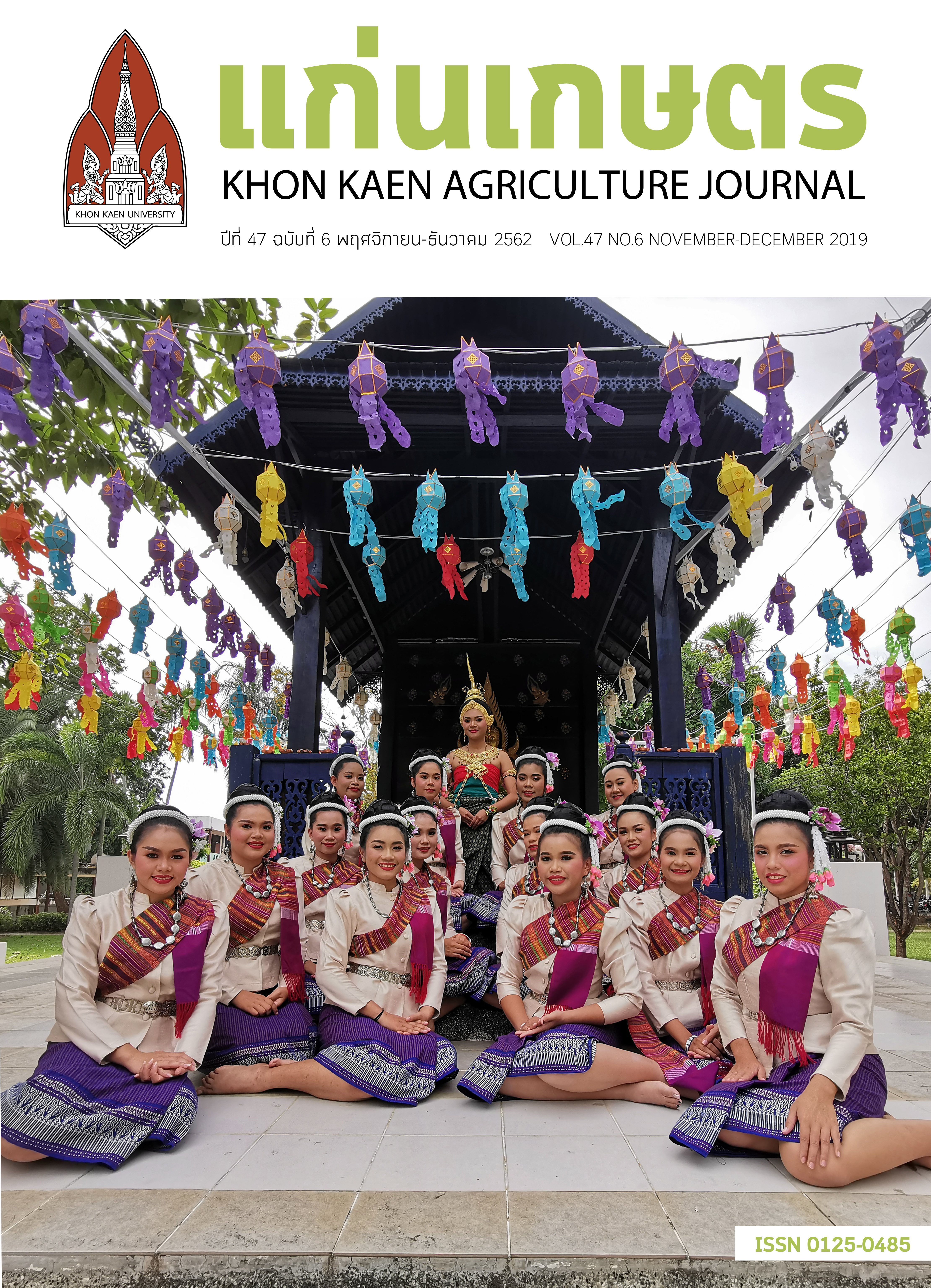ประสิทธิภาพ ของราปฏิปักษ์ Chaetomium spp. ต่อ Phytophthora palmivora (P-05) สาเหตุ โรครากและโคนเน่าทุเรียน
Main Article Content
บทคัดย่อ
จากการออกสำรวจโรครากและโคนเน่าทุเรียนในเขตพื้นที่จันทบุรี ตาก และอุตรดิตถ์ ในระหว่างพฤษภาคม 2560 ถึงตุลาคม 2561 สามารถแยกเชื้อรา Phytophthora spp. รวม 28ไอโซเลต เมื่อนำมาทดสอบความสามารถในการก่อโรคพบว่าเชื้อรา Phytophthora palmivora ไอโซเลต P-05 เป็นสายพันธุ์ที่ก่อให้เกิดโรครุนแรง เมื่อนำมาทดสอบกับเชื้อราปฏิปักษ์ที่เก็บรวบรวมและแยกเชื้อบริสุทธิ์ได้จากตัวอย่างวัสดุเหลือใช้ทางการเกษตรรวม 19 ไอโซเลต ด้วยวิธี dual culture พบว่ามีเชื้อรา Chaetomium 3 ไอโซเลตคือ CMU-08, CMU-13 และ CMU-19 สามารถควบคุมเชื้อราไอโซเลต P-05 ได้ดี โดยมีค่ายับยั้งการเจริญของเส้นใย คือ 50.55, 48.89 และ 50.00 % ตามลำดับ เมื่อนำเชื้อรา Chaetomium ทั้ง 3 ไอโซเลตมาสกัดสารและนำสารสกัดหยาบมายับยั้งการเจริญและการสร้าง chlamydospore ของเชื้อราไอโซเลต P-05 พบว่า สารสกัดหยาบ ethyl acetate (CMU-13) สามารถยับยั้งการเจริญเส้นใยของเชื้อสาเหตุโรคได้ดีที่สุด โดยมีค่า ED50 เท่ากับ 0.14 มก./มล. ในขณะที่สารสกัดหยาบ methanol (CMU-08) สามารถยับยั้งการสร้าง chlamydospore ของเชื้อราไอโซเลต P-05 ได้ดีที่สุด โดยมีค่า ED50 เท่ากับ 0.93 มก./มล.
Article Details
เอกสารอ้างอิง
นุชนารถ จงเลขา. 2545. ราชั้นต่ำที่เป็นปรสิตของพืช Plant Parasitic Lower Fungi (ฉบับปรับปรุง). ภาควิชาโรคพืช คณะเกษตรศาสตร์ มหาวิทยาลัยเชียงใหม่, เชียงใหม่.
มานิตย์ ทองหอม. 2553. การปลูกทุเรียน. อักษรสยามการพิมพ์. กรุงเทพมหานคร.ศูนย์สารสนเทศการเกษตร สำนักงานเศรษฐกิจการเกษตร, 2561. แหล่งข้อมูล: http://www.oae.go.th/assets/portals/1/fileups/prcaidata/files/durian60.pdf2. ค้นเมื่อ 20 ธันวาคม 2561
แสวง ภูสิริ. 2527. เรื่องทุเรียน The story of durian. วิทยาลัยเกษตรกรรมตรัง, ตรัง.
Anitha, R. and Murugesan, K. 2001. Mechanism of action of Gliocladium virens on Alternaria helianthi. Indian Phytopathology. 54: 449-452.
Brewer, D., Duncan, J.M., Jerram, W.A., Leach, C.K., Safe, S., Taylor, A., Vining, L.C., Archibald, R.M., Stevenson, R.G., Mirocha, C.J., and Christensen, C.M. 1972. Ovineill-thrift in Nova Scotia. 5. The production and toxicology of chaetomin, a metabolite of chaetomium spp. Canadian Journal of Microbiology 18, 1129-1137.
Dar, J. and Soytong, K. 2014. Construction and characterization of copolymer nanomaterials loaded with bioactive compounds from Chaetomium species. International Journal of Agricultural Technology 10: 823-831.
Di Pietro A., M. Gut-Rella, J. P. Pachlatko and F. T. Schwinn. 1992. Role of antibiotics produced by Chaetomium globosum in biocontrol of Pythium utimum, a causal agent of damping-off. Phytopathology. 82: 131-135.
Durães, S. 2015. Pathogenicity tests of Phytophthora alni and Phytophthora plurivora in Fraxinus excelsior and Alnus glutinosa seedlings. M.S. Thesis. Universidad de Valladolid, Spain.
Emer O’Gara, S. Sangchote, L. Fitzgerald, D. Wood, A. Seng, and D. I. Guest. 2004. Infection Biology of Phytophthora palmivora Butl. in Durio zibethinus L. (Durian) and Responses Induced by Phosphonate. P.42-52. In: Diversity and Management of Phytophthora in Southeast Asia. BPA Print Group Pty Ltd, Melbourne, Australia.
Environment and Climate Change Canada Health Canada. 2017. Final Screening Assessment of Chaetomium globosum strain ATCC 6205. Government of Canada, Canada.Guest, D. I. 2004. Diversity and Management of Phytophthora in Southeast Asia. BPA Print Group Pty Ltd, Melbourne, Australia
Hung, P. M., P. Wattanachai, K. Soytong, and S. Poaim. 2015. Biological Control of Phytophthora palmivora Causing Root Rot of Pomelo Using Chaetomium spp. Mycrobiology. 43: 63-70.
Kanokmedhakul, S., K. Kanokmedhakul, P. Nasomjai, S. Louangsysouphanh, K. Soytong, M. Isobe, P. Kongsaeree, S. Prabpai, and A. Suksamrarn. 2006. Antifungal azaphilones from the fungus Chaetomium cupreum CC3003. Journal of Natural Products. 69: 891-895.
Kapoor, N., M. Tyagi, H. Kumar, A. Arya, M.A. Siddiqui, A. Amir, and A.S. Malik. 2010. Production of cellulose enzyme by Chaetomium sp. using wheat straw in solid state fermentation. Research Journal of Microbiology. 5: 1199-1206.
Park, J.-H., G. J. Choi, K. S. Jang, H. K. Lim, H. T. Kim, K. Y. Cho, and J. C. Kim. 2005. Antifungal activity against plant pathogenic fungi of chaetoviridins isolated from Chaetomium globosum. FEMS Microbiology Letters. 252: 309-313.
Pongpisutta, R. and S. Sangchote. 2004. Morphological and Host Range Variability in Phytophthora palmivora from Durian in Thailand. P.53-58. In: Diversity and Management of Phytophthora in Southeast Asia. BPA Print Group Pty Ltd, Melbourne, Australia.
Pornsuriya, C., Soytong, K., Kanokmedhakul, S. and Lin, F.C. 2010. Efficacy of antifungal metabolites from some antagonistic fungi against Pythium aphanidermatum. Journal of Agricultural Technology. 6: 299-308.
Soytong, K. 2553. Evaluation of Chaetomium - Biological Fungicide to Control Phytophthora Stem and Root Rot of Durian. Rajamangala University of Technology Tawan-ok Research Journal. 3: 115-124.
Soytong, K., S. Kanokmedhakul, V. Kukongviriyapa, and M. Isobe. 2001. Application of Chaetomium species (Ketomium®) as a new broad spectrum biological fungicide for plant disease control: A review article. Fungal Diversity 7: 1-15.
Suksiri, S., P. Laipasu, K. Soytong, and S. Poeaim. 2018. Isolation and identification of Phytophthora sp. and Pythium sp. from durian orchard in Chumphon province, Thailand. International Journal of Agricultural Technology 14:389-402.
Suzui, T. J., U. Kueprakone, and T. Kamphangridthrong. 1979. Phytophthora spp. Isolated from some economic plants in Thailand. Technical Bulletin Tropical Agricultural Research Center. 12: 32-41.
Tann, H. and K. Soytong. 2016. Bioformulations and nano product from Chaetomium cupreum CC3003 to control leaf spot of rice var. Sen Pidoa in Cambodia. International Journal of Plant Biology. 7: 59-63.
Thongkham, D., K. Soytong, S. Kanokmedhakul, and K. Kanokmedhakul. 2018. Nanoparticles derived from Chaetomium elatum against Phytophthora rot of durian. International Journal of Agricultural Technology. 14: 2115-2124.
Tongon, R., K. Soytong, S. Kanokmedhakul, and K. Kanokmedhakul. 2018. Nano-particles from Chaetomium brasiliense to control Phytophthora palmivora caused root rot disease in durian var Montong. International Journal of Agricultural Technology 14: 2163-2170.
Waterhouse, G. M. 1963. Key to the species of Phytophthora de bary. Mycological Papers. 92: 1-22.


